Allianz Arena
Football World Cup 2006 Germany
Allianz Arena
| Allianz Arena |
| "Schlauchboot" |
|
|
| Facility statistics |
| Location |
Werner-Heisenberg-Allee 25
80939
Munich
Germany |
| Broke ground |
October 21, 2002 |
| Opened |
May 30, 2005 |
| Closed |
Open |
| Demolished |
N/A |
| Owner |
Bayern München - 50%
TSV 1860 München - 50% |
| Operator |
Allianz Arena München Stadion GmbH |
| Surface |
Grass |
| Construction cost |
€ 286 million (Euros) |
| Architect |
Jacques Herzog
Pierre de Meuron |
| Tenants |
Bayern München (Bundesliga)
TSV 1860 München (2. Bundesliga) |
| Seating capacity |
| 69,901 |
The Allianz Arena is a
football (soccer) stadium in the north of Munich. The Allianz
group, a large financial services provider, bought the rights to name the
arena for 30 years, but it will nevertheless be known as "FIFA World Cup
Stadium Munich" during the
2006 World Cup, since
FIFA does not
allow sponsorship of stadium names.
FC Bayern München will also be required to cover up the stadium name during
UEFA Champions League Cup games due to similar restrictions of the
UEFA. During
UEFA Cup games the stadium will be known as "Munich Arena".
The two professional Munich football clubs
FC Bayern München and TSV 1860 München have played their home games at Allianz Arena since the
start of the 2005/06 season. Both clubs had previously played their home
games at the
Munich Olympic Stadium since
1972.
Within a few months of opening day, the distinctive shape of the Allianz
Arena had inspired the nickname Schlauchboot ("inflatable raft") by
which it is now commonly known.
Stadium specifics
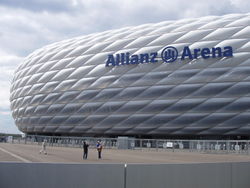 A view from the south
A view from the south
The stadium is located at the northern edge of Munich's borough of
Schwabing
on the Fröttmaning Heath.
Capacity
Effective with the city's approval of modifications that was granted
January 16, 2006, the legal capacity of the stadium has increased from
66,000 to 69,901 spectators (including standing room). The lower tier can
seat up to 20,000, the middle tier up to 24,000, and the upper tier up to
22,000. 10,400 of the seats in the lower tier corners can be converted to
standing room to allow an additional 3,120 spectators. The total capacity
includes 2,200 business seats, 400 seats for the press, 106 luxury boxes
with seating for up to 1,374 and 165 berths for wheel chairs and the like.
From the second half of the 2005-06 Bundesliga season, the arena will be
able to accommodate 69,901 spectators at league and German Cup games, but because of
UEFA
regulations, the capacity will remain at 66,000 seats for
UEFA Cup
games. The partial roof covers all seats, although winds can still blow rain
onto some of them.
Allianz Arena also offers three day-care centers, two fan shops, the FC
Bayern München Megastore and the TSV 1860 München Allianz Arena Megastore.
Merchandise is offered at stands all along the inside of the exterior wall
inside the area behind the seats. Numerous restaurants and fast food
establishments are also located around the stadium.
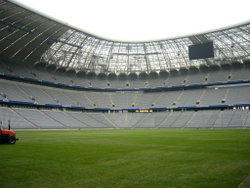 Allianz Arena at playing level
Allianz Arena at playing level
There are four team locker rooms (one each for the two home teams and
their respective opponents), four coaches' locker rooms and two locker rooms
for referees. Two areas are provided where athletes can warm up (approx. 110
m2 each). There are also 550 toilets and 190 monitors in the
arena.
Dimensions
Stadium: 258m x 227m x 50m
Playing level: 120m x 83m
Gross grass area: 111m x 72m
Playing field: 105m x 68m
Parking garage: 270,000m2
Construction
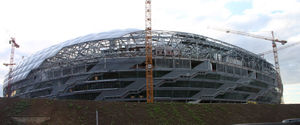 Allianz Arena under construction (August 2004)
Allianz Arena under construction (August 2004)
- Total concrete used during stadium construction: 120,000m3
- Total concrete used for the parking garage: 85,000m3
- Total steel used during stadium construction: 22,000 metric tons
- Total steel used for the parking garage: 14,000 metric tons
The arena facade is constructed of 2,874
ETFE-foil air
panels that are kept inflated with dry air to a differential pressure of
0.035 hPa. The
foil has a thickness of 0.2mm. Each panel can be independently lit with
white, red, or blue light. The intention is to light the panels at each game
with the colors of the respective home team, or white if the home team is
the
German national football team. Roller blinds installed under the roof
may be drawn during games to provide protection from the sun.
Parking
Patrons may park their cars in Europe's largest parking structure,
comprising four 4-story parking garages with 9,800 parking places. In
addition, 1,200 places were built into the first two tiers of the arena, 350
places are available for buses (240 at the north end, and 110 at the south
entrance), and 130 more spots are reserved for those with disabilities.
Surroundings
From the subway station just south of the arena, visitors approach the
stadium through a park that was designed to disentangle and guide them to
the entrance. An
esplanade
rises gradually from ground level at the subway station entrance, passing
the parking garage, to the entrance level of the stadium.
Owners
The arena was commissioned by the Allianz Arena München Stadion GmbH,
founded in 2001, which is owned in equal parts by the two football clubs
that call it home. The GmbH's CEO was
Karl-Heinz Wildmoser Jr. until the unraveling of the stadium corruption
affair (see below). Since then, Bernd Rauch, Peter Kerspe and Walter
Leidecker have led the company.
Name
The
Allianz AG paid significant sums for the right to lend its name to the
stadium for a duration of 30 years.
Cost
The cost of the construction itself ran to € 286 million but financing
costs raised that figure to a total of € 340 million. In addition, the city
and State incurred approximately € 210 million for areal development and
infrastucture improvements.
Reactions
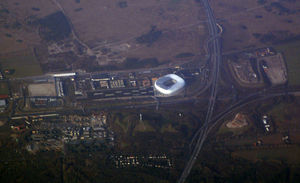 Aerial photo of Allianz Arena with surrounding area just before
construction was complete (January 2005)
Aerial photo of Allianz Arena with surrounding area just before
construction was complete (January 2005)
On November 14, 2005 at the annual general meeting, many FC Bayern München club members complained
about the uncomfortable draft inside the arena. As a result, closable doors
were installed and spectators now enjoy watching the games in greater
comfort.
The Ultras
and many other fans protested at several home games against the seats and
some of the rules of the arena which they perceive as "fan unfriendly". For
example, a spectator may not enter with a megaphone or a pennant that a
single person cannot carry unfurled, and pennant poles with a length of over
one meter are prohibited. The complaint is that these rules and the designer
seats put a damper on the fan experience. The presence of a large fence and
safety nets in front of the southern curve (seat bloc reserved for fans of
the FC Bayern München) are also often criticized.
In reaction to the heavy commercialization that followed the rejection of
the Ultra movement in the media, and some other actions of the
FC Bayern München football club, the stadium has sometimes been dubbed
"Arrogance Arena".
History
 Seating area of the Allianz Arena
Seating area of the Allianz Arena
On October 21, 2001 voters went to the polls to determine whether a new stadium should
be built in this location and whether the city of Munich should provide the
necessary infrastructure. About two thirds of the voters decided in favor of
the proposition. An alternative to constructing the new arena had been a
major reconstruction of the
Olympic Stadium but this option had been refused by its architect
Günther Behnisch.
The Swiss architect firm of Herzog & de Meuron then developed the concept
of the stadium with a see-through exterior made of ETFE-foil panels, that
can be lit from the inside and are self-cleaning. Construction started in
the fall of 2002 and was completed by the end of April 2005.
The Fröttmaning and Marienplatz stations of the subway line U6 were
expanded and improved in conjunction with the arena construction. The
Fröttmaning subway station was expanded from two to four tracks and the
Marienplatz train station was outfitted with additional pedestrian connector
tunnels along track U toward the subway station. To be able to handle the
additional traffic load the Autobahn
A 9 was expanded to three and four lanes going each way and another exit was
added to the A 99 north of the arena.
Stadium corruption affair
Since March 2004 a corruption affair relating to the stadium has occupied
the football world and German courts. On March 9 Karl-Heinz Wildmoser Sr.,
president of the TSV 1860 München, his son Karl-Heinz Wildmoser Jr., chief
executive officer of Allianz Arena München Stadion GmbH, and two others were
charged with corruption in connection with the award of arena construction
contracts and taken into custody. On March 12, 2004 Wildmoser Sr. struck a
plea bargain and was released. As part of the plea bargain he relinquished
the presidency of the club three days later and on May 18 the
investigation into his conduct was closed.
His son Karl-Heinz Wildmoser Jr. remained in custody. At a bail hearing
on June 29 the judge refused bail on the grounds of danger of flight and
obstruction of justice. The District Attorney filed charges on August 23,
2004, accusing him of fraud, corruption and tax evasion. The case was that
Wildmoser Jr. had awarded the construction contract at an inflated price,
provided the Austrian
builder Alpine with inside information that enabled the builder to win the
contract, and in return received € 2.8 million.
On May 13, 2005 Karl-Heinz
Wildmoser Jr. was convicted and sentenced to 4-1/2 years in prison. He was
released on bail pending his appeal.
Opening day
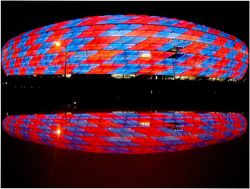 Allianz Arena lit up
Allianz Arena lit up
On May 30, 2005, TSV 1860 München played an exhibition game against 1. FC
Nürnberg. The next day the record German champions Bayern Munich played a
game against the German national team. Both games had been sold out since
early March 2005. Patrick Milchraum of TSV 1860 scored the first official goal at the
stadium.
On June 2, in response to high demand, the first "arena derby" took place
between the two owners. That game was won by TSV 1860 with the help of a
goal by Paul Agostino.
Prior to opening day the alumni teams of both clubs played each other in
an exhibition game in front of a crowd of 30,000 where all stadium functions
were thoroughly tested.
The stadium's first goal in a competitive game went to
Owen Hargreaves of FC Bayern when the home team won 3–0 in its 2005/06
Bundesliga season opener against Borussia Mönchengladbach on August 5, 2005.
The first goal in an official game by an visiting team was scored by Dynamo
Dresden on September 9, 2005 in the Second Bundesliga match against TSV 1860
München. That game ended in a score of 2–1 in front of a full house which
included approximately 15,000 - 18,000 fans who had traveled to Munich from
Dresden
for the game.
The first goal against FC Bayern München in a league game at Allianz
Arena was scored by Miroslav Klose of SV Werder Bremen on November 5, 2005 in the first minute of play. This was to remain the visitors' only
goal that day as the game went to the FC Bayern with a final score of 3–1.
FC Bayern broke its consecutive sell-out record by selling out each of
its first ten home games at Allianz Arena.
Football World Cup 2006
 Inside Allianz Arena
Inside Allianz Arena
The stadium will be one of the venues for the
Football World Cup 2006, however due to sponsorship contracts the arena
will be called "FIFA World Cup Stadium Munich" during the World Cup.
The following games will be played at the stadium during the World Cup of
2006:
Reference
Much of the content of this article comes from the equivalent
German-language wikipedia article (retrieved February 5, 2006). Additional information was taken off the official website of the
arena.
External links
Home | Up | Olympic Stadium | Signal Iduna Park | Commerzbank-Arena | Veltins-Arena | AOL Arena | AWD-Arena | Fritz Walter Stadion | RheinEnergieStadion | Zentralstadion | Allianz Arena | Frankenstadion | Gottlieb-Daimler-Stadion
Football World Cup 2006, made by MultiMedia | Free content and software
This guide is licensed under the GNU
Free Documentation License. It uses material from the Wikipedia.
|




